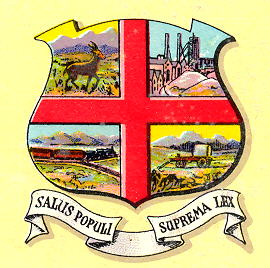Germiston: Difference between revisions
Knorrepoes (talk | contribs) No edit summary |
Knorrepoes (talk | contribs) m (Text replace - "[[Literature" to "{{media}} [[Literature") |
||
| Line 24: | Line 24: | ||
The scene in the second quarter suggests mining, and the ox-wagon in the fourth quarter was a Transvaal symbol, alluding to the Voortrekkers (emigrants) who migrated from the Cape Colony in the 1830s and '40s to escape British rule. | The scene in the second quarter suggests mining, and the ox-wagon in the fourth quarter was a Transvaal symbol, alluding to the Voortrekkers (emigrants) who migrated from the Cape Colony in the 1830s and '40s to escape British rule. | ||
{{media}} | |||
[[Literature]] : Scan from first day cover and tobacco card | [[Literature]] : Scan from first day cover and tobacco card | ||
Revision as of 21:54, 8 July 2014
| Heraldry of the World Civic heraldry of South Africa |
GERMISTON
Province : Gauteng (formerly Transvaal Province)
Metropolitan Municipality : Ekurhuleni
Official blazon
Gules, within two bendlets Or between two ox-wagons Argent, three bezants.
Origin/meaning
The arms were officially granted in 1935.
The arms symbolise the gold mining (bezants), the wagons are the symbol of the Transvaal. I have no information on the other elements.
Previously the city used the arms below:
The scene in the second quarter suggests mining, and the ox-wagon in the fourth quarter was a Transvaal symbol, alluding to the Voortrekkers (emigrants) who migrated from the Cape Colony in the 1830s and '40s to escape British rule.
Contact and Support
Partners:
Your logo here ?
Contact us
© since 1995, Heraldry of the World, Ralf Hartemink 
Index of the site
Literature : Scan from first day cover and tobacco card












